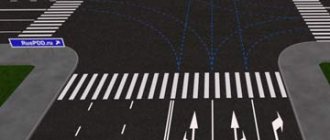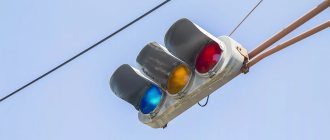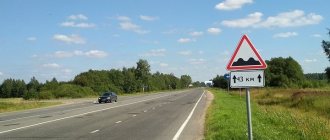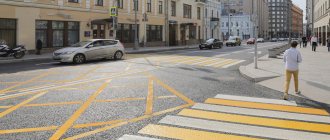As a rule, in driving schools during training they do not pay increased attention to such a maneuver as oncoming vehicle traffic. Therefore, drivers do not perform it correctly in all cases.
Meanwhile, it is necessary to master the rules of this maneuver better - it will not be necessary to perform it as rarely as it might seem.
In fact, there are no particular difficulties in this maneuver. In order not to receive fines due to incorrect adherence to the rules, you just need to thoroughly familiarize yourself with them.
Punishment - fine
The Code of Administrative Offenses, Article 12.15, Part 1, defines a fine for failure to comply with the rules of oncoming traffic . The amount can range from one thousand to one and a half thousand rubles. Deprivation of the right to drive a car in such cases is not provided.
The decision on the amount may depend on the specific situation. In a narrow passageway, a fine may be assigned at a lower level. If you incorrectly follow the rules of oncoming traffic on a fairly wide road, the fine may be the largest possible.
What is this according to traffic rules?
Those who are just beginning to master the rules should consider in detail what oncoming traffic is and when exactly it is necessary. On the road, the need to pass may arise in situations where its width is not sufficient for two vehicles moving towards each other to pass along it at the same time. The need to use travel rules may arise in the following situations :
- If there was an accident on the road and half of it was blocked.
- If work is underway on the road, occupying a large part of it.
- When cars are parked in several rows at the edge of the roadway.
You are more likely to end up on a road that is not wide enough for travel in winter. At this time, utility services do not always manage to remove the snow on time; as a result, it takes up a lot of space on the roadway. At the same time, on some roads they continue to park personal vehicles in the same way as in the summer - because of this, the road quickly turns into a single-lane road.
Oncoming traffic on a slope: who gives way and when and why contradictions are possible
Narrow roads with a slope are found not only outside the city, but also in courtyards, and many drivers, when necessary to pass oncoming traffic, begin to remember who should give way - the one going up or down. In fact, different options are possible here - let's remember the conditions and remember a simple rule that will help us forever understand who should give in.
The traffic rules do not define the concept of “oncoming passing”, but in practice this is a simple situation when cars moving towards each other on the road cannot pass through a certain section at the same time, and it is necessary to determine the order of passage. You can come up with a lot of examples: an accident on a lane, a narrowing of the road due to snow, road work on one of the lanes, parked in violation of traffic rules
cars and just a narrow section of road in the yard, not designed for oncoming traffic.
In practice, there are two scenarios for oncoming traffic on a slope, and they depend on the presence of signs. Let's consider both cases in order.
In practice, there are situations that do not fall under the conditions outlined above: for example, driving on a narrow road in the local area, where two cars cannot initially pass each other, or driving on a section of the road, on both sides of which, in violation of traffic regulations, cars are parked, narrowing the roadway up to one row. That is, either none of the oncoming drivers have an obstacle, or both have it - in such a situation, neither of them has priority. In this case, the departure is carried out by mutual agreement, taking into account the “good” clause 1.5 of the traffic rules: “road users must act in such a way as not to create a danger to traffic and not cause harm.”
For example, if you are moving down a slope on a slippery yard road and see the need to pass, you can stop in advance and turn to the right, giving the oncoming car moving uphill the opportunity to drive through the difficult section without stopping.
Anyone approaching the crossing point under sign 2.6 must give way to oncoming drivers, even those who are approaching the obstacle, and those driving under sign 2.7 have priority in traffic.
By failing to give way or causing an accident while passing oncoming traffic, you can receive a fine under Part 1 of Article 12.15 of the Code of Administrative Offences. According to it, “ violation of the rules of oncoming traffic entails the imposition of an administrative fine in the amount of 1,500 rubles
».
Source
A sign instructing the driver to give way if vehicle maneuvers are difficult
If sign 2.6 is installed at the beginning of a narrow section of the road, the driver must give vehicles moving from the opposite direction the right of way.
Sign “Right of way for oncoming traffic” 2.6:
Typically, such a sign is installed in places where it would be difficult for two cars to pass each other . For example, it is often placed at the beginning of bridges with a narrow roadway.
This rule may not be used if the dimensions of your vehicles do not cause difficulties when driving through a narrow area (for example, when passing motorcycles without side trailers). In this case, there is no need to stop and let oncoming vehicles pass - drivers simply pass the road.
General order of execution
The traffic rules for oncoming traffic are discussed in some detail.:
- If there are difficulties with oncoming traffic due to an obstacle that has arisen on the road, the driver on whose side there is one will have to give way.
- If the obstacle is located on slopes that are indicated by signs 1.13 (steep descent) and 1.14 (steep climb), the driver who is going down the mountain gives way.
Steep descent sign 1.13: Steep climb sign 1.14:
This paragraph includes two rules - of which the first is applied only and exclusively for slopes, and for all other situations there is a second rule. It is worth taking into account that we are not talking about all slopes, but only about those indicated by signs 1.13 and 1.14.
- If there are warning signs and there are problems with passing vehicles on a narrow section of the road, the driver who descends from it gives way to the mountain. This rule applies regardless of which side there is an obstacle.
- All other situations on the roads are resolved as follows: if there are problems, the driver on whose side there is an obstacle gives way.
Sequence of actions in different road conditions
- At the crossroads . Oncoming traffic at intersections is not as difficult as it seems. For example, both cars are about to turn left. Passing can be done on the right side - in this case, the cars turn before reaching each other. If the passing is carried out on the left sides, the cars, having caught up, pass each other and turn. Such options are acceptable in the traffic rules.
- On the slope . If you need to pass on a mountainside, the first thing you need to remember is that the sign of ascent is considered a sign of advantage. When passing on an uphill road marked with a special warning sign, you will have the right of way. When descending from the mountain, you will have to give way to oncoming cars, if necessary.
- On a narrow area . If it is necessary to pass each other on a narrow road, drivers should be guided by signs establishing traffic priorities. Thus, it becomes clear which direction will be preferential and which driver should be the first to direct the vehicle into a narrow area.
- When overtaking . Sometimes cars moving in different directions end up in the same lane - this happens when one vehicle overtakes. In this case, the one who is overtaking must give way.
- When going around an obstacle . If a car is forced to move into the oncoming lane because there is an obstacle in its lane, it will have to yield to other vehicles.
How to pass oncoming cars without an accident
While driving, motorists very often encounter situations where they need to pass oncoming traffic.
For example, this often happens when overtaking, changing lanes into oncoming traffic, or going around an obstacle. In such conditions, sudden movements are highly discouraged. Smooth lane changes are sometimes the main rule that prevents the occurrence of a traffic accident. As mentioned earlier, you can pass oncoming cars at a road intersection or while driving inside a yard. Particular difficulty arises when you need to go around an obstacle in too tight an area. In all of the above cases, you must rely, first of all, on the Traffic Rules, which may also differ depending on the situation.
Since it is almost impossible to avoid such cases, when driving around you need to follow the rules and correctly choose the time and distance to the oncoming car. Note that you can encounter a passing lane even in your own lane when another car is driving into the oncoming direction ahead. There is no such concept in the traffic rules; this is a situation in which cars moving in their lanes cannot do this on a certain section of the road at the same time. Here the main importance is given to the order of travel.
Slope . When driving on roads with signs 1.13 and 1.14, you must adhere to the established recommendations. The driver who is moving downhill must give way. The fact is that if a driver who is moving uphill gives way, it will be difficult for him to move off after stopping. Please note that such guidance only works if appropriate signs are installed on the road.
Narrow roads . When cars park on the road, the passage becomes too narrow. Two drivers will not be able to pass each other at the same time. There are no rules set here either. You need to act by agreement with another person. One of the motorists will have to reverse. In some cases, narrow roads may be marked with signs 2.6 and 2.7, which determine the order of travel. Violation of the rules is punishable by a fine of 1.5 thousand rubles.
Bottom line . Every motorist on the road repeatedly encounters the need for oncoming traffic. In such situations, you need to be guided not only by traffic rules, but also by experience.
Source
Controversial situations during violations
It is not uncommon for a driver who suddenly has an obstacle in his path, does not have time to get his bearings and breaks the rules by driving around to a part of the road for oncoming traffic. In this case, he will need to provide convincing evidence that the violation was committed due to extreme necessity . In most cases, this helps avoid punishment. Find out in what cases and how you can appeal a traffic police fine here.
Driving into a lane intended for oncoming traffic and violating the rules of passing are considered an administrative offense if road signs and markings directly prohibit this maneuver (what are the fines for violating the rules of maneuvering?). Controversial situations arise in the absence of markings, if they have been erased from the road in places - then driving into another lane will not be punishable by deprivation of rights.
Oncoming traffic: perform the maneuver safely
You have to resort to oncoming traffic quite often. And we’re not just talking about overtaking in oncoming traffic, which threatens a head-on collision. This maneuver is used when driving through intersections, when driving around in courtyards, and when going around obstacles. Moreover, the Rules apply differently in each case.
Any driver simply cannot do without overtaking and changing lanes. After all, it’s impossible to spend hours trailing behind a slow-moving vehicle moving along a suburban single-lane highway at a speed of 20 km/h. Here even a beginner will decide to overtake. And if another car appears in the oncoming lane, you won’t crash into it. Here's an example of oncoming traffic.
However, it is not at all necessary to leave your lane to bump into an oncoming car. Firstly, other motorists also often resort to overtaking. They can also drive into your lane if, for example, there are road works underway on their half of the road or there is a huge pothole.
But most often the cause of oncoming traffic is cars parked on the sidewalks (sometimes even in several rows). And if you add to them mountains of snow that they forgot to remove on time in winter, then often the road becomes so crowded that you have to go into oncoming traffic to get through the bottleneck.
Rules for oncoming traffic in various traffic situations
· When avoiding obstacles and overtaking
It would seem that there is nothing complicated about oncoming traffic: whoever occupies someone else’s lane is obliged to give way. This is true if we are talking about meeting an obstacle on only one side of the roadway.
The situation is similar with the one who is overtaking: in order to avoid a collision, he must return to his lane in time. In this case, priority goes to those moving on their own half of the road.
But sometimes traffic rules require giving way even on your own half of the road. For example, while climbing a slope. This situation occurs even in exam papers. Let us take it apart.
What should you do in this situation?
1. Give way to an oncoming car.
3. Act by mutual agreement with the driver of the oncoming car.
The traffic rules clearly regulate oncoming traffic in this case (Section 13.4 of the Traffic Regulations). A driver climbing a mountain has an advantage even if a pile of earth of unknown origin is an obstacle blocking his lane of the road. The main reason is that it is much more difficult for a driver on an uphill slope to move on further after stopping (it’s not for nothing that the mandatory exercise “Overpass” was introduced in the practical exam).
But it is worth remembering that this rule does not apply to every hillock. The slope must be marked with the following signs:
(Sign 1.13 “Steep descent”) – (Sign 1.14 “Steep ascent”)
In this way, only the steepest and most dangerous slopes are marked. On them, the driver going up the hill always has the advantage.
So the correct answer in this exam problem is 1. A car going down a slope must allow a car moving towards it to pass, regardless of which side of the roadway the obstacle is on.
Sometimes you have to make oncoming traffic at an intersection. For example, when you and an oncoming car needed to turn left. In this case, you can pass each other on both the right and left sides. In the first case, the cars will not reach each other. In the second, they will catch up and, having passed each other, turn around. Drivers choose the algorithm of actions themselves, since the Traffic Rules allow both options - as long as motorists do not end up in oncoming traffic after leaving the intersection.
Imagine a road so narrow (for example, due to cars parked along the side of the road) that it is simply impossible for two cars to pass on it at the same time. Such bottlenecks are often found at exits from courtyards or in courtyard arches. Moreover, in this situation it is generally unclear whose lane it is: yours or that of the motorist who is driving towards you. So the traffic rules are powerless here.
If neither driver has an advantage, then it is necessary to first agree on further maneuvers. You can do this with gestures (you can read about special gestures for motorists in this article), and if that doesn’t work, you’ll have to get out of the car and talk in person. It’s better to spend a couple of minutes on this than then, in the event of a collision, wait for hours for the police or deal with the registration of the Europrotocol.
How can the traffic police prove your guilt?
To prove the driver’s guilt, traffic police officers must provide materials containing comprehensive information on a specific violation. In addition to the protocol, which is drawn up at the scene of the violation, witness testimony may be provided. But more often the work is carried out with documents obtained through photography and video.
Video cameras have recently been installed in many disputed areas in order to control traffic on the roads and test drivers’ knowledge of traffic rules. You should not ignore such areas - getting a fine after violating traffic rules recorded by cameras is as easy as shelling pears. Find out more about what is recorded by the camera and whether it is possible to appeal the punishment with video recording of the violation in a separate article.
On our portal we also talked about traffic police fines: for driving without documents and while drunk, for driving through a prohibitory traffic light and for tinting the front and side windows, for license plates and lighting devices
.










